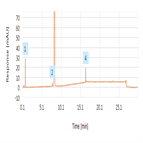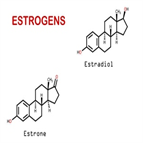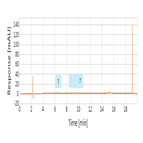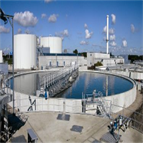Find methods for your needs
Refine by Feature
Displaying 1-5 of 11 results for Tag: Estrogen
Related substance analysis of Estradiol Valerate as per EP using Accucore C18 HPLC column
Instrument Type: HPLCThe Thermo Scientific Dionex UltiMate 3000 LC system is applied for the analysis of Related substance of Estradiol Valerate as per EP. The analysis was performed on a Thermo Scientific Accucore C18 HPLC column using the method described in the EP monograph. The results obtained were found to be within acceptance criteria as stated in the monograph. Resolution between Impurity C & estradiol valerate peak was observed to be 3.18 in the refernce solution, a (Criteria is NLT 2.5)
Quantitative Comparison of Hormones in Drinking Water Between MS/MS and Orbitrap Technology
Instrument Type: LCMSMSWe present a a liquid chromatography – high-resolution, accurate mass (LC-HRAM) methodology using Orbitrap technology as a sensitive, accurate, and reliable alternative to the use of triple quadrupole mass spectrometers in the quantification of hormones in drinking water according to EPA guidelines. By using different scanning modes within the Q Exactive MS, quantitation on precursor ions and identification of fragments ions are possible. These scanning modes can possibly be used for compliance monitoring in place of a triple quadrupole MS.
High-Throughput LC-MS/MS Quantification of Estrone (E1) and Estradiol (E2) in Human Blood Plasma/Serum for Clinical Research Purposes
Instrument Type: LCMSMSEstrone (E1) and estradiol (17-beta-estradiol or E2) are two of several estrogens involved in the development and function of female anatomical and physiological characteristics and processes such as the menstrual cycle. Researchers seek to quantify E1 and E2 within an analytical range of 5 to 500 pg/mL (18.5 to 1,850 pmol/L) in blood plasma or serum. E1 and E2 form negative ions by deprotonation in both ESI and APCI MS sources. In order to robustly achieve the needed quantitation limits, most researchers use dansyl chloride to form positively charged derivatives of these and other estrogens.
TN148: Automated Extraction and Determination of Human Hormones in Drinking Water Using Solid-Phase Extraction and HPLC with UV Detection
Instrument Type: HPLCThis Technical Note describes the use of high-surface-area solid phase extraction (SPE) to extract seven human hormones from drinking water using the Dionex AutoTrace 280 SPE instrument. Extracts were subsequently quantified using high-performance liquid chromatography (HPLC) to determine the recovery.
Quantitative and Semi-Quantitative Determination of PPCPs and Their By-Products in Wastewater by Orbitrap MS
Instrument Type: LCMSPharmaceuticals and personal care products (PPCPs) and endocrine disrupting chemicals (EDCs) detected in surface and drinking waters, as well as in treated wastewater. They are an issue of increasing international attention due to potential environmental impacts. We developed an analytical method capable of determining PPCPs and their by-products in wastewater treatment plant (WWTP) samples. This workflow was applied in a survey of 35 permeate samples obtained from a pilot anaerobic membrane bioreactor (AnMBR).





